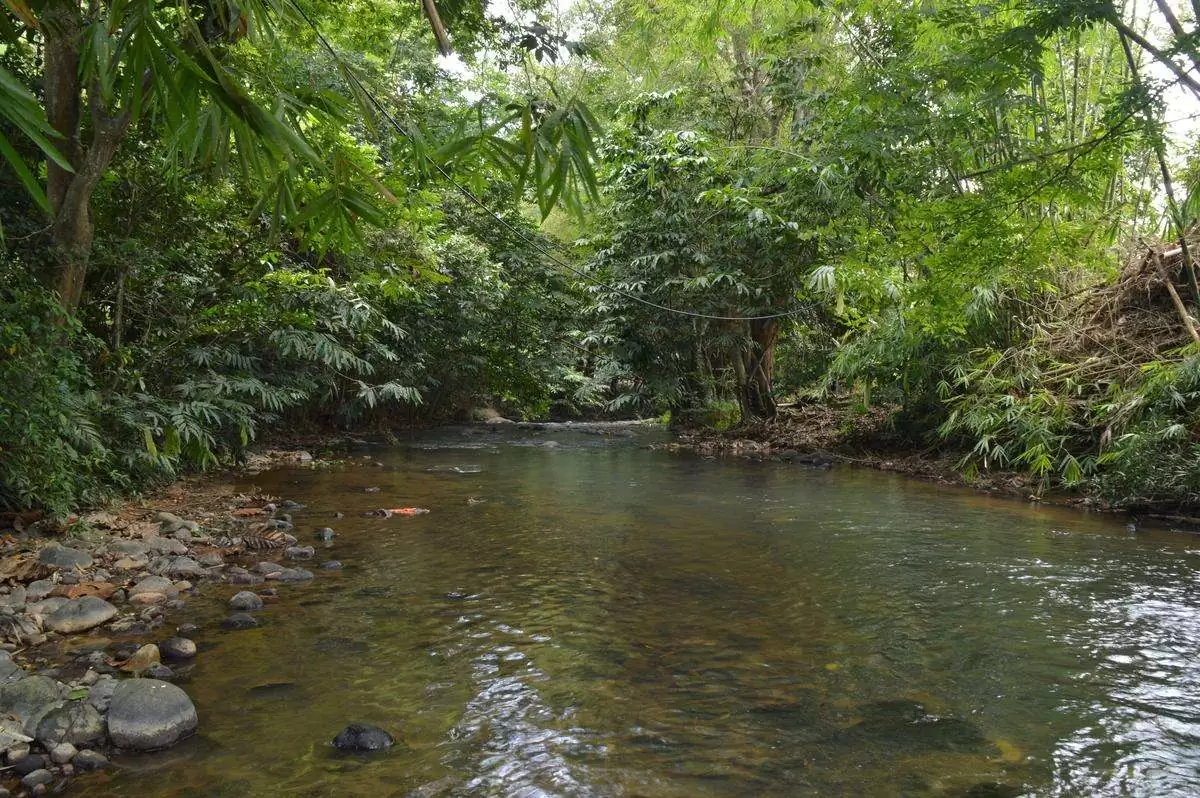

🌿 Picture a vast, mysterious landscape where land and water intertwine, creating a unique ecosystem unlike any other on Earth. Welcome to the Sundarbans, India’s largest forest and a UNESCO World Heritage Site. This enchanting mangrove wonderland is not just a feast for the eyes; it’s a thrilling adventure waiting to be explored.
Have you ever dreamed of encountering the majestic Bengal tiger in its natural habitat? Or perhaps you’ve longed to witness the intricate dance of nature in a pristine wilderness? The Sundarbans offers all this and more, but it’s also facing unprecedented challenges. Climate change, pollution, and human encroachment threaten this delicate ecosystem. As we embark on this journey through the Sundarbans, we’ll uncover its secrets, from its rich biodiversity to its cultural significance, and explore how we can play a part in preserving this natural treasure for generations to come.
Join us as we delve into the heart of the Sundarbans, exploring its unique geography, diverse flora and fauna, and the crucial role it plays in both the local economy and global conservation efforts. Get ready to discover why this extraordinary forest is not just a national pride for India, but a global marvel that demands our attention and protection. 🐯🌊🌴

The Sundarbans, the largest mangrove forest in the world, boasts a unique ecosystem that sets it apart from other forests. This vast expanse of tidal halophytic mangrove forest is characterized by its intricate network of tidal waterways, mudflats, and small islands of salt-tolerant mangrove forests.
Key characteristics of the Sundarbans mangrove forest include:
Salt-tolerant vegetation
Extensive root systems
Tidal influence
Diverse habitat zones
| Feature | Description |
|---|---|
| Aerial roots | Pneumatophores that emerge from the soil to facilitate oxygen intake |
| Vivipary | Seeds germinate while still attached to the parent tree |
| Buttress roots | Provide stability in soft, muddy soil |
| Salt excretion | Specialized glands in leaves to expel excess salt |
These adaptations allow mangroves to thrive in the challenging estuarine environment where freshwater from rivers meets the salty seawater.
The Sundarbans is a haven for biodiversity, hosting an impressive array of flora and fauna. This largest forest in India is home to numerous species, many of which are rare, endangered, or endemic to the region.
Notable wildlife in the Sundarbans includes:
Royal Bengal Tiger
Gangetic and Irrawaddy dolphins
Estuarine crocodiles
Various species of sea turtles
Over 260 bird species
The forest’s diverse ecosystem supports a complex food web, with each species playing a crucial role in maintaining ecological balance.
The Sundarbans plays a vital role in climate regulation, both locally and globally. As a massive carbon sink, it helps mitigate the effects of climate change by absorbing and storing significant amounts of carbon dioxide from the atmosphere.
Key climate regulation functions:
Carbon sequestration
Coastal protection
Temperature moderation
Water cycle regulation
The dense mangrove vegetation acts as a natural barrier against cyclones and storm surges, protecting coastal communities from the devastating impacts of extreme weather events.
In recognition of its exceptional natural beauty and ecological significance, the Sundarbans was designated as a UNESCO World Heritage Site in 1987. This status highlights the global importance of preserving this unique ecosystem for future generations.
The UNESCO designation covers:
Core areas of the Sundarbans National Park
Buffer zones
Transition areas
This recognition has helped raise awareness about the need for conservation efforts and sustainable management practices in the Sundarbans. It has also promoted eco-tourism, allowing visitors to experience the wonders of this remarkable forest while supporting local communities and conservation initiatives.
As we delve deeper into the Sundarbans ecosystem, it becomes evident that this largest forest in India is not just a geographical marvel but a critical component of our planet’s ecological balance. Its unique characteristics, rich biodiversity, and global significance make it a treasure trove of natural wonders waiting to be explored and protected.

The Sundarbans, the largest mangrove forest in the world, spans across India and Bangladesh. In India, it covers an area of approximately 4,262 square kilometers, making it the largest forest in the country. Located in the delta region of the Ganges, Brahmaputra, and Meghna rivers, the Indian part of the Sundarbans is situated in the state of West Bengal.
To put its size into perspective, consider the following comparison:
| Forest | Area (sq km) | Country |
|---|---|---|
| Sundarbans | 4,262 | India |
| Jim Corbett National Park | 520 | India |
| Kaziranga National Park | 430 | India |
As evident from the table, the Sundarbans dwarfs other well-known Indian forests in terms of size, underlining its significance as the largest forest in India.
The Sundarbans is characterized by its intricate network of tidal waterways, mudflats, and small islands. This unique landscape is formed by the constant interplay between land and sea, creating a maze-like ecosystem that is both beautiful and challenging to navigate.
Key features of the Sundarbans’ waterways and islands include:
Over 100 islands, of which 54 are inhabited
Numerous rivers, creeks, and channels that crisscross the region
Constantly changing landscape due to tidal action and sediment deposition
Mangrove-covered islands that serve as natural barriers against cyclones and storm surges
The climate of the Sundarbans is characterized by distinct seasonal variations, which play a crucial role in shaping the ecosystem and influencing human activities in the region. The area experiences three main seasons:
Summer (March to May):
Hot and humid conditions
Temperatures ranging from 20°C to 40°C
Occasional pre-monsoon showers
Monsoon (June to September):
Heavy rainfall, with an average annual precipitation of 1,600-1,800 mm
High humidity levels
Frequent storms and cyclones
Winter (October to February):
Mild temperatures, ranging from 12°C to 24°C
Relatively dry weather
Ideal time for wildlife spotting and tourism
The Sundarbans, being a low-lying coastal region, is particularly vulnerable to the effects of climate change. Some of the significant impacts observed and predicted include:
Sea-level rise: Threatening to submerge low-lying islands and erode coastlines
Increased salinity: Affecting mangrove growth and freshwater availability
More frequent and intense cyclones: Causing widespread damage to flora, fauna, and human settlements
Changes in rainfall patterns: Disrupting the delicate balance of the ecosystem
These climate change impacts pose significant challenges to the conservation of the Sundarbans and the livelihoods of local communities. As we delve into the rich biodiversity of this unique ecosystem, it’s important to keep in mind the delicate balance that exists between the geography, climate, and the myriad life forms that call the Sundarbans home.

The Sundarbans, as the largest forest in India, boasts an incredible variety of plant life adapted to its unique mangrove ecosystem. This diverse flora plays a crucial role in maintaining the ecological balance of the region. Let’s explore some of the most notable plant species found in this remarkable forest:
Mangrove trees:
Sundari (Heritiera fomes)
Goran (Ceriops decandra)
Keora (Sonneratia apetala)
Bain (Avicennia officinalis)
Palms and ferns:
Nipa Palm (Nypa fruticans)
Phoenix Paludosa
Acrostichum aureum (Golden leather fern)
Climbers and epiphytes:
Derris trifoliata
Finlaysonia obovata
Various orchid species
The Sundarbans’ plant life has uniquely adapted to the challenging conditions of the mangrove ecosystem, including high salinity, tidal fluctuations, and waterlogged soil. For instance, many species have developed specialized root systems, such as pneumatophores and stilt roots, to cope with these conditions.
The Bengal tiger (Panthera tigris) is undoubtedly the most iconic inhabitant of the Sundarbans forest. These majestic creatures have adapted to the unique mangrove habitat, developing remarkable swimming abilities and a diet that includes fish and crabs alongside their usual prey.
Key facts about Sundarbans tigers:
| Characteristic | Description |
|---|---|
| Population | Estimated 100-150 individuals |
| Habitat | Mangrove forests and tidal creeks |
| Unique traits | Excellent swimmers, smaller in size compared to mainland tigers |
| Diet | Varied, including deer, wild boar, fish, and occasionally humans |
| Conservation | Critically endangered, protected by strict anti-poaching measures |
The Sundarbans tigers face numerous challenges, including habitat loss, human-wildlife conflict, and the impacts of climate change. Conservation efforts are crucial to ensure the survival of this unique population.
The Sundarbans’ intricate network of waterways and estuaries supports a rich diversity of aquatic life. Some notable species include:
Gangetic dolphin (Platanista gangetica)
Irrawaddy dolphin (Orcaella brevirostris)
Estuarine crocodile (Crocodylus porosus)
Olive ridley sea turtle (Lepidochelys olivacea)
Various species of fish, including the iconic Hilsa
The mangrove ecosystem serves as a crucial nursery for many marine species, providing shelter and nutrients for juvenile fish and crustaceans. This makes the Sundarbans an essential contributor to the region’s fisheries and overall marine biodiversity.
The Sundarbans is home to several rare and endangered species, making it a critical area for conservation efforts. Some of these species include:
Fishing cat (Prionailurus viverrinus)
Ganges river shark (Glyphis gangeticus)
King cobra (Ophiophagus hannah)
Masked finfoot (Heliopais personatus)
Batagur baska (Northern river terrapin)
These species face various threats, including habitat loss, pollution, and climate change. Conservation initiatives in the Sundarbans focus on protecting these vulnerable species and their habitats.
The rich biodiversity of the Sundarbans underscores its importance as a unique ecosystem. As we move forward, it’s crucial to consider how we can explore this remarkable forest while ensuring its preservation for future generations.

The Sundarbans, as the largest forest in India, is not just a natural wonder but also home to diverse local communities whose lives are intricately woven with the forest ecosystem. These communities have adapted to the unique challenges of living in a mangrove forest, developing distinct cultures and traditions.
The people of the Sundarbans engage in various occupations that are closely tied to the forest and its resources:
Fishing
Honey collection
Wood gathering
Crab catching
Prawn seed collection
These activities form the backbone of the local economy and shape the daily lives of the inhabitants.
| Occupation | Challenges | Importance |
|---|---|---|
| Fishing | Tiger attacks, cyclones | Primary source of income |
| Honey collection | Bee stings, getting lost | Unique forest product |
| Wood gathering | Legal restrictions, deforestation | Fuel and construction |
| Crab catching | Crocodile encounters | Growing export market |
| Prawn seed collection | Environmental impact | Aquaculture industry |
The Sundarbans forest has inspired a rich tapestry of myths and legends that reflect the deep connection between the local people and their environment. These stories often revolve around the forest’s most iconic inhabitant – the Bengal tiger.
One of the most prominent legends is that of Bon Bibi, the guardian deity of the Sundarbans. According to local belief, Bon Bibi protects the forest dwellers from the dangers of the wild, especially from tiger attacks. This legend showcases the unique syncretic culture of the region, blending elements of Islam and Hinduism.
The folklore of the Sundarbans is replete with other mythical beings:
Dakkhin Rai: A shape-shifting tiger god
Gazi Pir: A Muslim saint with power over tigers
Nol Raja: A snake deity
These legends not only entertain but also serve as a means of passing down ecological knowledge and promoting conservation ethics among the local communities.
The Sundarbans has played a significant role in the history of the region, influencing trade, politics, and culture for centuries.
As part of the ancient maritime Silk Road, the Sundarbans served as a crucial waypoint for traders and explorers. Its strategic location at the mouth of the Ganges delta made it an important hub for commerce between South Asia, Southeast Asia, and beyond.
During the British colonial period, the Sundarbans gained importance for:
Timber extraction
Revenue generation
Natural barrier against invasions
The forest’s resources were extensively exploited during this time, leading to significant ecological changes.
Today, the Sundarbans continues to be of immense historical and cultural importance. It serves as a living testament to the resilience of both nature and human communities in the face of environmental challenges. The forest’s unique ecosystem and the cultural practices of its inhabitants offer valuable insights into sustainable living and the delicate balance between humans and nature.

The best time to explore the Sundarbans, India’s largest forest, is during the winter months from November to February. This period offers the most favorable weather conditions for visitors, with comfortable temperatures and minimal rainfall. The cool climate makes it ideal for outdoor activities and wildlife spotting.
| Season | Months | Temperature Range | Advantages |
|---|---|---|---|
| Winter | Nov-Feb | 12°C – 25°C | Pleasant weather, peak wildlife activity |
| Summer | Mar-Jun | 20°C – 35°C | Less crowded, lower prices |
| Monsoon | Jul-Oct | 25°C – 35°C | Lush greenery, fewer tourists |
The Sundarbans offers a diverse range of activities for nature enthusiasts and adventure seekers:
Wildlife spotting: Look for Bengal tigers, crocodiles, and various bird species
Boat safaris: Navigate through the intricate network of waterways
Mangrove walks: Explore the unique ecosystem on foot
Bird watching: Observe migratory and resident bird species
Photography: Capture the stunning landscapes and wildlife
To make the most of your Sundarbans experience, consider joining guided tours and safaris. These professionally organized excursions offer:
Expert naturalists providing in-depth knowledge about the ecosystem
Increased chances of wildlife sightings
Safety measures and proper equipment
Customized itineraries based on interests and duration of stay
Many tour operators offer packages ranging from day trips to multi-day expeditions, allowing visitors to tailor their experience to their preferences and schedule.
When visiting the Sundarbans, the largest forest in India, you have several accommodation choices:
Eco-lodges: Sustainable options that blend with the natural surroundings
Houseboats: Unique floating accommodations for an immersive experience
Government-run forest rest houses: Basic facilities within the forest
Private resorts: Comfortable amenities on the outskirts of the forest
While exploring the Sundarbans, it’s crucial to prioritize safety:
Always follow guide instructions and stay with your group
Wear appropriate clothing and footwear for outdoor activities
Use insect repellent to protect against mosquitoes
Avoid littering and maintain a safe distance from wildlife
Carry essential medications and a first-aid kit
Now that you’re equipped with information on when to visit, what activities to enjoy, and how to stay safe, let’s delve into the conservation efforts being made to protect this unique ecosystem.

The Indian government has implemented several crucial initiatives to protect and preserve the Sundarbans, recognizing its importance as the largest forest in India. These efforts aim to maintain the delicate balance of this unique ecosystem while addressing the challenges posed by climate change and human activities.
Project Tiger: Launched in 1973, this flagship conservation program has been instrumental in protecting the Bengal tiger population in the Sundarbans.
Sundarbans Biosphere Reserve: Established in 1989, this initiative promotes conservation, sustainable development, and scientific research in the region.
Mangrove restoration programs: The government has initiated large-scale mangrove plantation drives to combat coastal erosion and enhance biodiversity.
| Initiative | Year Launched | Key Objectives |
|---|---|---|
| Project Tiger | 1973 | Tiger conservation, habitat protection |
| Sundarbans Biosphere Reserve | 1989 | Ecosystem preservation, sustainable development |
| Mangrove Restoration | Ongoing | Coastal protection, biodiversity enhancement |
Non-governmental organizations (NGOs) play a vital role in supporting conservation efforts in the Sundarbans. These organizations work closely with local communities, government agencies, and international partners to implement various programs:
Wildlife protection: NGOs conduct regular surveys, monitor species populations, and assist in anti-poaching efforts.
Community development: Organizations focus on providing alternative livelihoods to reduce dependence on forest resources.
Environmental education: NGOs raise awareness about the importance of the Sundarbans ecosystem through workshops, training programs, and educational materials.
Despite ongoing conservation efforts, the Sundarbans face numerous challenges that threaten its long-term survival:
Climate change: Rising sea levels and increased salinity pose significant risks to the mangrove ecosystem and wildlife habitats.
Human-wildlife conflict: As human settlements expand, encounters between locals and wildlife, particularly tigers, have become more frequent.
Pollution: Industrial waste, oil spills, and plastic pollution negatively impact the delicate balance of the Sundarbans ecosystem.
Overfishing: Unsustainable fishing practices deplete marine resources and disrupt food chains.
Visitors to the Sundarbans can play a crucial role in supporting conservation efforts:
Choose responsible tour operators: Select eco-friendly tour companies that prioritize sustainable practices and contribute to local conservation initiatives.
Follow park rules: Adhere to guidelines set by park authorities to minimize human impact on the ecosystem.
Reduce plastic use: Bring reusable water bottles and avoid single-use plastics during your visit.
Support local communities: Purchase locally-made products and services to promote sustainable livelihoods.
Spread awareness: Share your experiences and knowledge about the Sundarbans to raise awareness about its importance and conservation needs.
By implementing these measures and supporting ongoing conservation efforts, we can help ensure the long-term survival of the Sundarbans, India’s largest forest and a unique ecosystem of global importance. As we move forward, it’s crucial to recognize the economic significance of this remarkable region and how it contributes to the livelihoods of millions.

The Sundarbans play a crucial role in sustaining the livelihoods of millions of people living in and around the forest. This unique ecosystem provides a diverse range of economic opportunities for local communities, ensuring their survival and well-being. Let’s explore some of the key ways in which the Sundarbans contribute to the local economy:
Fishing and aquaculture
Honey collection
Agriculture
Handicrafts and artisanal products
Fishing is one of the primary sources of income for the inhabitants of the Sundarbans. The rich marine ecosystem supports a variety of fish species, crustaceans, and mollusks. Local fishermen employ traditional fishing methods and small-scale aquaculture practices to harvest these resources sustainably.
| Species | Economic Value | Sustainability Concerns |
|---|---|---|
| Hilsa | High | Overfishing |
| Prawns | High | Habitat destruction |
| Crabs | Medium | Climate change impact |
| Mollusks | Low | Pollution |
The Sundarbans, being the largest forest in India, provides a wealth of timber and non-timber forest products (NTFPs) that contribute significantly to the local and national economy. While strict conservation measures are in place to protect the forest, sustainable harvesting of certain products is allowed under careful regulation.
Sundari trees: Used for construction and boat-building
Gewa trees: Utilized for making matchsticks and paper pulp
Honey and beeswax
Medicinal plants
Fuelwood
Thatching materials
The Sundarbans’ unique biodiversity and stunning landscapes make it an ideal destination for ecotourism. This growing sector has the potential to generate substantial revenue while promoting conservation efforts. Key attractions include:
Wildlife safaris to spot Bengal tigers
Mangrove forest boat tours
Bird watching expeditions
Cultural experiences with local communities
The Sundarbans play a vital role in protecting coastal communities from natural disasters, indirectly contributing to the economic stability of the region. The dense mangrove forests act as a natural barrier against:
Cyclones and storm surges
Coastal erosion
Tidal floods
By reducing the impact of these natural calamities, the Sundarbans help minimize economic losses and safeguard infrastructure in nearby areas. This protective function is especially crucial given the increasing frequency and intensity of extreme weather events due to climate change.
The economic importance of the Sundarbans extends far beyond its immediate surroundings. As the largest forest in India, it plays a significant role in carbon sequestration, contributing to global climate regulation efforts. This ecological service has potential economic value in the form of carbon credits and international conservation funding.

The Sundarbans, India’s largest forest, is a mesmerizing blend of natural wonders and cultural richness. From its unique mangrove ecosystem to its diverse wildlife, including the iconic Bengal tiger, this UNESCO World Heritage site offers an unparalleled experience for nature enthusiasts and adventure seekers alike. The forest’s significance extends beyond its ecological importance, playing a crucial role in the local economy and serving as a natural barrier against cyclones.
As we continue to face environmental challenges, the conservation of the Sundarbans becomes increasingly vital. By supporting sustainable tourism practices and local conservation efforts, we can help preserve this extraordinary ecosystem for future generations. Whether you’re planning a visit or simply aiming to learn more about this natural marvel, the Sundarbans stands as a testament to the intricate balance between humans and nature, inviting us all to appreciate and protect its irreplaceable beauty.


